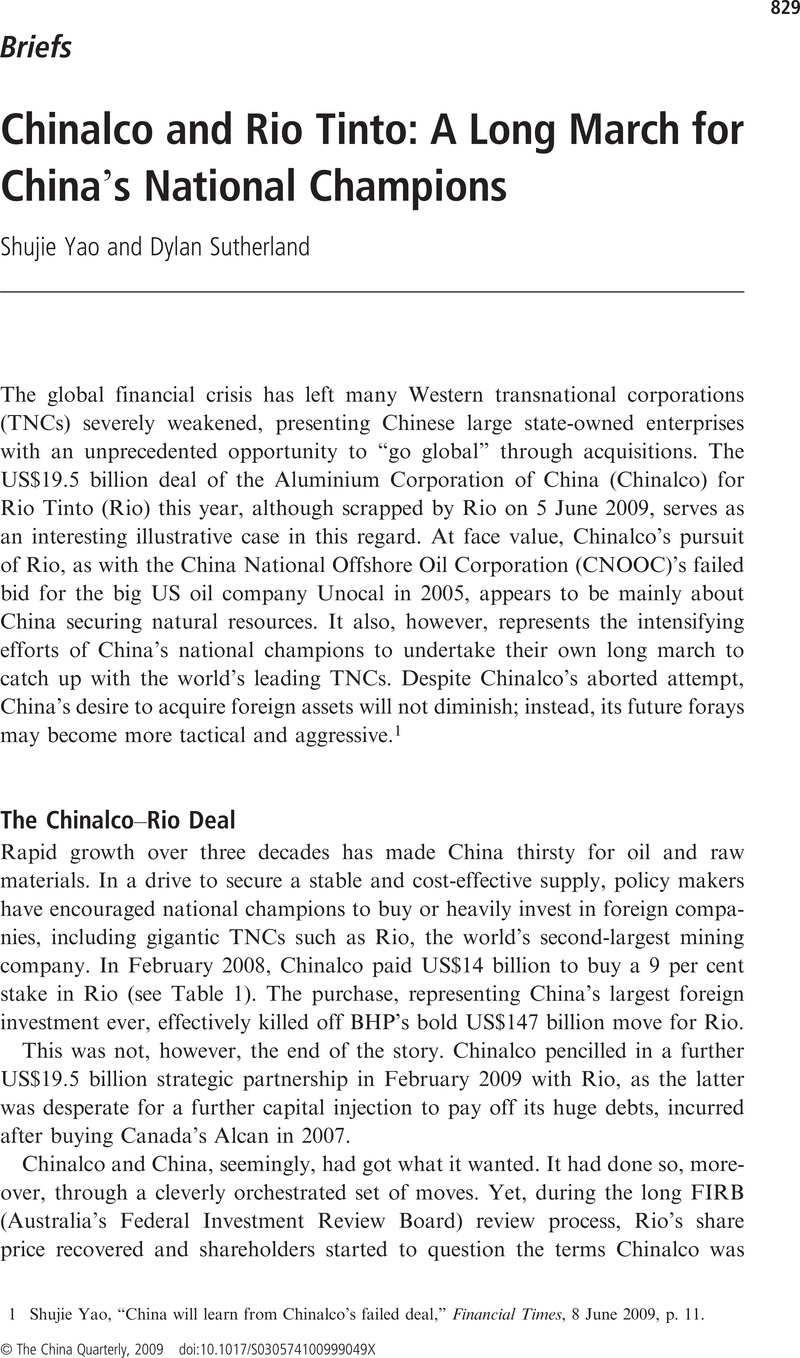Article contents
Chinalco and Rio Tinto: A Long March for China's National Champions
Published online by Cambridge University Press: 10 September 2009
Abstract

- Type
- Briefs
- Information
- Copyright
- Copyright © The China Quarterly 2009
References
1 Yao, Shujie, “China will learn from Chinalco's failed deal,” Financial Times, 8 June 2009, p. 11Google Scholar.
2 Ironically, this was in part driven by China's own massive stimulus packages.
3 World Bank, “Global economic prospects: commodities at the crossroads,” in World Bank (ed.), Global Economic Prospects (Washington DC: World Bank, 2009), pp. 196Google Scholar.
4 UNCTAD, “World Investment Report 2007: Transnational Corporations, Extractive Industries and Development,” World Investment Report (New York and Geneva: UNCTAD, 2007), pp. 323.
5 Ibid.
6 World Steel Association, “Top steel producers 2007,” (Brussels: World Steel Association, 2009), available from http://www.worldsteel.org/.
7 Yang, Zhen, “Easier loans lead to more M&As,” China Daily, 20 April 2009, p. 4Google Scholar.
8 See for example Morck, R., Yeung, B. and Zhao, M., “Perspectives on China's outward foreign direct investment,” Journal of International Business Studies, Vol. 39 (2008), pp. 13CrossRefGoogle Scholar, and Child, J. and Rodrigues, S. B., “The internationalization of Chinese firms: A case for theoretical extension?,” Management and Organization Review, Vol. 1, No. 3 (2005), pp. 19CrossRefGoogle Scholar.
9 Sutherland, D., “Policies to build national champions: China's ‘national team’ of enterprise groups,” in Nolan, P. (ed.), China and the Global Business Revolution (New York: Palgrave, 2001), p. 1092Google Scholar.
10 SSB, Large Corporations of China 2007, (Beijing: China Statistics Press, 2008)Google Scholar.
11 Sutherland, D., “Do China's “national team” business groups undertake strategic-asset-seeking OFDI?,” Chinese Management Studies, Vol. 3, No. 1 (2009), pp. 13CrossRefGoogle Scholar.
12 Lex, “No dim sum”, Financial times, 16 March 2009, p. 24.
13 Fortune, “Fortune 500,” Fortune (CNN Money, 2009), SSB, Large Corporations of China 2007, (Beijing: State Statistical Bureau, 2009)Google Scholar.
14 Nolan, Peter, China and the Global Business Revolution (New York: Palgrave, 2001), pp. 1092CrossRefGoogle Scholar.
15 All companies, even big foreign private companies – as China's recent rejection of Coke's bid for the famous Huiyuan juice brand shows – may face similar political obstacles.
- 13
- Cited by


